
Enamored with cartoons as a kid, Eric Bauza desired to be a cartoon-maker himself. He grew up in Scarborough, a borough of Toronto, where he attended Blessed Cardinal Newman Catholic High School, followed by Centennial College, graduating in radio, television, and film production. Bauza learned that Spümcø, John Kricfalusi’s studio in the U.S., needed interns for The Ripping Friends (2001). Hired as a production assistant, he moved to Los Angeles to live with his aunt and uncle. Kricfalusi gave Bauza the opportunity to do voiceover, beginning with a Tooth Filling (“The Indigestable Wad”) and Future Cat (“The Infernal Wedding”), a character based on Amid Amidi who was a Spümcø production coordinator at the time.
After the show’s cancellation, Bauza returned to Canada, working at Funbag Animation in Ottawa. He rejoined Kricfalusi on Ren and Stimpy: Adult Party Cartoon (2003) for Spike TV, working as a production manager, animatic editor—and the new voice of Stimpy, replacing Billy West.
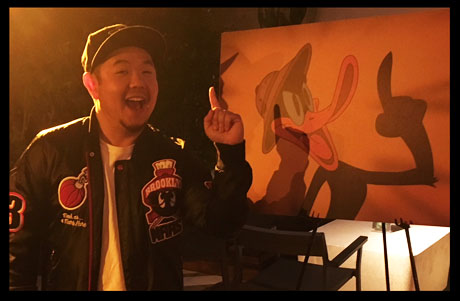
Following a dry spell, Bauza worked as a character layout artist at Six Point Harness in Los Angeles. Then he scored a major role, Rodolfo Rivera/White Pantera, on El Tigre: The Adventures of Manny Rivera (2007) for Nickelodeon—a character he’d draw at Six Point. He voiced Destro, Storm Shadow, Tunnel Rat on G.I. Joe Resolute (2009), Anti Foop on Fairly Oddparents (2009), and Lord Stingray on Superjail! (2011).
With Good Vibes (2011), Bauza quit animation drawing altogether to focus on voicework—and his acting career exploded. His roles included Marvin the Martian on The Looney Tunes Show (2011), Buhdeauce on Breadwinners (2014), Puss in Boots for The Adventures of Puss in Boots (2015), Tiger Claw on Teenage Mutant Ninja Turtles (2014), Chairman Drek from the videogame Ratchet & Clank (2016), the Beagle Boys on the DuckTales reboot (2017), Woody Woodpecker on Woody Woodpecker (2017), Baby Fozzie on the CG Muppet Babies (2018), Splinter in Rise of the Teenage Mutant Ninja Turtles (2018) and Leonardo in Batman vs. Teenage Mutant Ninja Turtles (2019). As of this writing, IMDb lists 232 credits for him.
Bauza also voiced Belly Bag on Uncle Grandpa (2013), a show created and produced by Peter Browngardt—who is now executive producer and creative director of Looney Tunes Cartoons. For this series, Bauza is voicing Bugs Bunny, Daffy Duck, Marvin the Martian, Pepé Le Pew, Tweety, Hubie and Bertie.
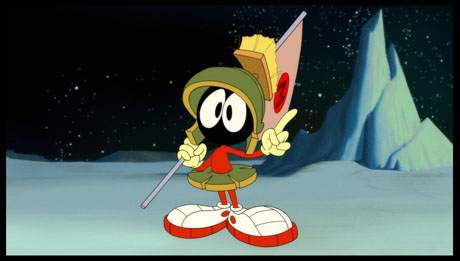
We talked about his career via Zoom on May 21st, 2020.
Eric Bauza: [As Daffy Duck] Testing, testing, one, two, three. We got good levels? Let’s roll, bub.
Bob Miller: That sounds great. Well, you know, with Mel Blanc’s Daffy, they speeded up his voice a little bit. It doesn’t sound like you do the same.
EB: Originally, when Mel did it, he was doing Sylvester. [Speaking as Sylvester] He had the same timbre as Sylvester [normal voice] but he just changed the acting for Daffy. And I’m kind of doing my own self-pitching and they don’t have to pitch me up much for Daffy, and [as Bugs Bunny] they don’t pitch me up at all for Bugs, Doc.
BM: Wow, (laughs) that’s great, that’s great. Let’s start at the beginning. How did you get interested in animation in the first place?
EB: Oh, man, Saturday morning cartoons, when you could only see cartoons at a certain time. Now, in this day and age, you just have to look on your phone. But when I was growing up in the 80s, cartoons could only be seen on Saturday mornings and after school. That’s when my obsession with the Warner Bros. franchise took over, not just Looney Tunes but Animaniacs and Tiny Toons, Freakazoid!, Batman: The Animated Series, Histeria!, Taz-Mania. Every Warner Bros. cartoon. I love Disney, [as Daffy] “but I just looooove Warner Bros.” (laughs)
BM: That’s great. How did you decide to pursue this as a career?
EB: Well, at a certain point in Canada, especially during the 90s, there was that big animation boom. Disney and Warner Bros. had the mothership. They would come and abduct all of our animators and bring them to the U.S. I have an uncle that lives here in L.A. who always sent me articles in the L.A. Times about animation. I really do have to thank him for planting those seeds about turning animation into an actual career, whereas, most Filipino men my age are nurses. (chuckles) It’s a career choice that not a lot of people want to take a risk on, because artists are feast or famine, not just voiceover artists but artists across the board. If you’re a musician, you really gotta play for your food. And if no one’s listening then you’ve got to go back to plumbing school.
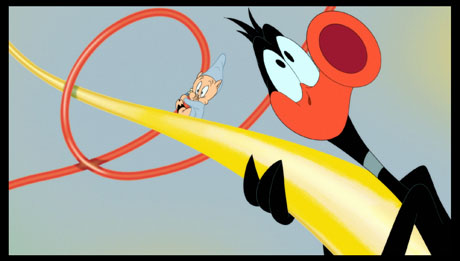
BM: Well, speaking of school, did you train at Sheridan [in Toronto] or did you train on the job here in L.A.?
EB: Oddly enough, I was an animator and as a character layout artist long before I had an interest in voiceover. I was in second round auditions to become part of the animation program at Sheridan. And then in-between the waiting, I got accepted at another college called Centennial College. Actually, the campus happens to be the same backdrop where they shot Degrassi High (1989-1991). It was a very popular show in Canada that got some play in the United States, but I went to school there and I graduated with a diploma in radio, television, and film production. I wasn’t even interested in acting, but, put me behind a circuit board and I can operate audio for you at a radio station.
BM: What training did you receive in Los Angeles?
EB: Oh, all of the colleagues and friends that I made here in L.A. were always aware that I had an obsession and a knack for manipulating my voice and the idea of wanting to become a voice actor. It was just a matter of booking that first gig, which was through Jorge Gutierrez and Sandra Equihua, from El Tigre: The Adventures of Manny Rivera. That was the very first American show I was a lead character in for an animated series. And the notes that I got back were, “He’s a very nice kid and he can do funny voices, but he’s a terrible actor.” So I kinda took those notes to heart.
Something happened after two to three years. I just got it. You’re in a room with people like Tara Strong and Tom Kenny, John DiMaggio, Rob Paulsen, Tress MacNeille, Jess Harnell. These are people that I grew up watching and I never thought in a million years I’d be in the same room with, acting and running scenes. And they really did rub off, they really did. They’re very generous and kind, and they showed me the ropes and eventually I just kind of got it.
BM: So you learned on the job.
EB: Absolutely. Again, specifically in the world of voiceover, I’ve never ever met more generous people in my entire life, and people that really are rooting for you.
BM: You were a character designer. Did you find that discipline of any help? I mean, they say animators are like actors with pencils or nowadays, styluses. Did that background help you as a voiceover person?
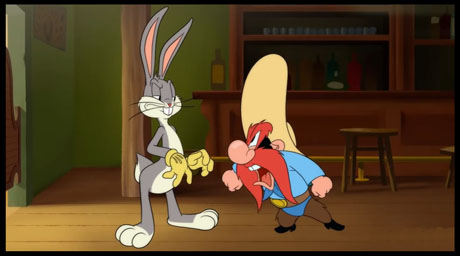
EB: Oh, absolutely. Long before I started acting with people like Cree Summer and Tara Strong, I was drawing on the Drawn Together movie. So as an artist, you’re working on these scenes—say the scene is anywhere between one second to five seconds—you’re hearing the actors on a loop as you kind of animate to their voices. So by way of repetition and listening to a lot of scenes, I would hear performances of my colleagues and go, “Oh, okay. There are some nuances there.” And, yeah, definitely being on the other side of the microphone or the glass, as you might say, definitely helped prepare me for a career in voiceover.
BM: When this new series of Looney Tunes came up, how did you find out about it? What did you do to gain the roles that you got now, as Bugs and Daffy?
EB: Joe Alaskey, rest in peace, could say he was the only actor or successor to Mel Blanc that did a Mel Blanc voice while Mel was still alive. And that would be the one famous scene in Who Framed Roger Rabbit when Yosemite Sam goes over the wall saying, [as Yosemite Sam] “My biscuits are burning. Fire in the hatch.”
BM: (laughs)
EB: That was Joe Alaskey. The rumor was when Mel Blanc saw it in theaters, he didn’t know that wasn’t him. That’s how good Joe Alaskey was. And all the legendary people like Jeff Bergman, and Greg Burson, and Billy West, have taken turns doing the voice. Now when I say taken turns, it’s not always up to the actor. We get auditions in the email from our agents and we kind of go, “Okay.” It’s usually “may the best man who’s doing it currently, get the gig.” And it’s also in a way, up to the showrunners and the directors. Not everyone is the same. The actors may remain the same, but the vision and what the showrunner wants to hear out of the performance, changes. And it’s really their choice at the end of the day who they pick. It’s not the actor’s choice. I have nothing but love and respect for Jeff, but I have the same amount of love and respect for Bugs Bunny.
As a voiceover actor, you get that email and you’re like, “Well, I have to read—” Just to say that I read for it even if I don’t book it. ‘Cause I’ve only read for Bugs Bunny twice in ten years. Knowing that Jeff was back and able to do the voice, and he did it for Looney Tunes Show, and he did it for Wabbit, and New Looney Tunes and was amazing. But again, it changed hands to Pete Browngardt and Sam Register (President of Warner Bros. Animation and Warner Digital Series). I think they wanted to try something new with these characters, so they opened it back up.
BM: Did you get the roles with a blind audition?
EB: That I’m not too sure of; I can’t say. I wasn’t in the room when they selected who they wanted, but I imagine that, that may have been the case. Sometimes they do that because they just want to hear it for what it is, and not for who is doing it.
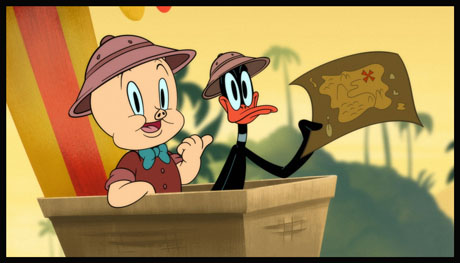
BM: How intimidating is it to voice these Warner Bros. legacy characters?
EB: Insanely intimidating and nerve-racking. [as Daffy] “I haven’t had a good night’s sleep since 2011. I don’t know, it’s great. And now there’s coronavirus.” You’re under the microscope of generations of people that know these characters better than you do. And I’m even a big critic of my performance. I was watching some of the episodes and go, “Oh, that was definitely at the beginning of the last two years.”
We’ve been recording these now for two years so when people come out and go, “Oh, well that sounded awful.” I really do hope that they hang on for a couple more episodes and go, “Oh, he finally got it.” Or, “Now he’s more comfortable with the voice.” And it also helps to have people in the room like Bob Bergen, who has worked with three Daffys in his lifetime. And when someone like him leans over and says, “You’re the closest Daffy to Mel Blanc,” I take those compliments to heart because he met Mel Blanc and Jeff met Mel Blanc. And we’re all thankful that he created such tentpole characters for us to have work in 2020. Can you believe that?
BM: Well, I’ve seen a handful of the shorts and you guys are doing an amazing job. I’ve got to compliment you on that.
EB: I really appreciate that, sir.
BM: Sure. And now, you’re recording at home because of the coronavirus situation?
EB: Yeah. I had a session with the Muppet Babies earlier, the Jim Henson Muppet Babies. Well, they’re Disney Muppet Babies now. And I’ll be having another session right after we talk. I’m not one of those actors that has the fancy sound booth. I have a fancy walk-in closet that has a lot of unfolded cartoon t-shirts lying around everywhere. So I got the perfect sound proofing, and I just hope my neighbors know that I don’t have more than 10 people here ‘cause that would be considered a mass gathering. It’s just 10 characters that I’m voicing. (chuckles)
BM: Do you try to match the acoustics of the classic recordings?
EB: Yeah, you know, it’s funny because I can only imagine that they were all on ribbon microphones, analog, straight to tape, and they were probably on a sound stage. ‘Cause if you watch a lot of the old ones, there is that weird room noise quality and the hissing like this, “sssss.” It’s constantly there. And if you listen to these ones, I think that the engineers were trying to match that same kind of quality by putting a slight room tone, or a room echo in there. Nothing too drastic, but definitely I think, they were trying to do something different on this one. And I hope it’s lending itself to the performance and not taking away.
BM: Okay. How much leeway does the director give you in terms of improvising?
EB: Oh, yeah. We’ll do a take as written. And then we’ll do two passes, and then maybe a third pass where we get to go off the rails and really go for it. And sometimes they work, sometimes it doesn’t. And other times it’s just a perfect marriage of the two.
BM: That’s great. Well, Eric, thank you so much for your time. This has been a pleasure and I wish you all the best.
EB: [As Bugs Bunny] “Eh, be safe out there, Doc. Don’t forget to wash your hands and wear your masks. That’s all folks.”
Special thanks to Jordan Van Brink, Vice President of 42West.


 May 29th, 2020
May 29th, 2020  W.R. Miller
W.R. Miller  Posted in
Posted in  Tags:
Tags: 







